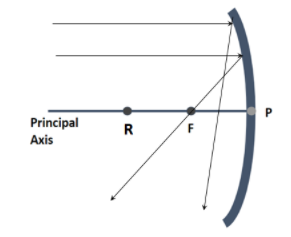
For a concave mirror, paraxial rays are focused at a distance \[\dfrac{R}{2}\] from the pole and marginal rays are focused at a distance \[x\] from the pole, then \[R\] will be
(a) \[x = \dfrac{R}{2}\]
(b) \[x = - f\]
(c) \[x > \dfrac{R}{2}\]
(d) \[x < \dfrac{R}{2}\]
Answer
507.9k+ views
Hint: This question can be solved by understanding the meaning of paraxial rays and marginal rays. The ray which forms a small angle with respect to the optical axis is referred to as a paraxial ray whereas a marginal ray is a ray that passes through the maximum aperture of the spherical mirror. As the marginal mirror strikes the mirror at its edges they go through more deviation than paraxial rays.
Complete step-by-step solution:

Since marginal rays have more deviation than when compared to paraxial rays as seen from the figure, it is understood that the paraxial and marginal rays meet at different points on the axis.
Since the paraxial rays are closer to the principal axis, once it strikes the mirror it is observed that the ray passes through the focus. Now we know that $f = \dfrac{R}{2}$. From the question also it is given that paraxial rays are focused at a distance \[\dfrac{R}{2}\] from the pole.
Since the marginal rays pass through the maximum aperture, the angle formed by the ray after it reflects from the mirror is large. Therefore we observe that the ray passes in between the pole and the focus. Hence we can see that the value of x, the distance from the pole for a marginal ray is less than \[\dfrac{R}{2}\].
Option d is the correct answer.
Note: Paraxial are the lines/rays situated alongside, or on each side of an axis. The marginal ray starts at the point where the object crosses the optical axis.
Complete step-by-step solution:

Since marginal rays have more deviation than when compared to paraxial rays as seen from the figure, it is understood that the paraxial and marginal rays meet at different points on the axis.
Since the paraxial rays are closer to the principal axis, once it strikes the mirror it is observed that the ray passes through the focus. Now we know that $f = \dfrac{R}{2}$. From the question also it is given that paraxial rays are focused at a distance \[\dfrac{R}{2}\] from the pole.
Since the marginal rays pass through the maximum aperture, the angle formed by the ray after it reflects from the mirror is large. Therefore we observe that the ray passes in between the pole and the focus. Hence we can see that the value of x, the distance from the pole for a marginal ray is less than \[\dfrac{R}{2}\].
Option d is the correct answer.
Note: Paraxial are the lines/rays situated alongside, or on each side of an axis. The marginal ray starts at the point where the object crosses the optical axis.
Recently Updated Pages
Master Class 11 Accountancy: Engaging Questions & Answers for Success

Master Class 11 Science: Engaging Questions & Answers for Success

Master Class 11 Business Studies: Engaging Questions & Answers for Success

Master Class 11 English: Engaging Questions & Answers for Success

Master Class 11 Computer Science: Engaging Questions & Answers for Success

Master Class 9 General Knowledge: Engaging Questions & Answers for Success

Trending doubts
Which are the Top 10 Largest Countries of the World?

Draw a labelled sketch of the human eye class 12 physics CBSE

State the principle of an ac generator and explain class 12 physics CBSE

Differentiate between insitu conservation and exsitu class 12 biology CBSE

Sketch the electric field lines in case of an electric class 12 physics CBSE

Give 10 examples of unisexual and bisexual flowers




